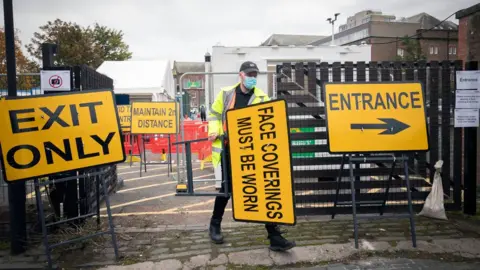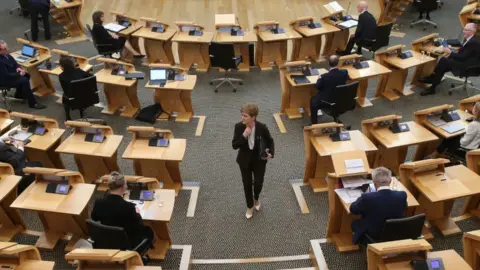Covid: Scotland to enter new five-level alert system
Scotland is to enter a new five-level system of coronavirus restrictions, Nicola Sturgeon has confirmed.
The new model will come into force from 2 November, when temporary curbs on the hospitality trade are due to expire.
It features five tiers of measures - from "level zero" to four - to be applied in different areas of Scotland depending on the spread of the virus.
The top level would be close to a full lockdown, but the aim is for schools to remain open at all levels.
Restrictions under levels two and three are similar to those which are currently in place for different parts of Scotland.
The first minister said the new strategy was about "striking the best balances we can" between suppressing the virus and minimising wider harms to businesses and individuals.
The move in Scotland comes as tougher restrictions are brought into force for millions of people in England and Wales.
Coronavirus cases in Scotland continue to rise, with 1,401 registered on Friday alongside a further 18 deaths.
The latest figures from the Office for National Statistics suggest the virus is spreading across the UK, with 1 in every 180 people in Scotland thought to have been infected in the two weeks to 16 October.
Ms Sturgeon said the ban on home visits and the short-term restrictions currently imposed on bars and restaurants in the central belt of the country in particular were beginning to slow the increase in cases.
However, she said restrictions would still be needed until a vaccine for the virus was developed, adding: "Everything we do must be consistent with suppressing Covid as far as we can."


The first minister said there would be talks with opposition parties and representatives of businesses - particularly from the hospitality trade - about the exact details of the different levels.
Decisions on which tier each part of Scotland will be placed in will be made alongside local health protection teams in the coming week.
Ms Sturgeon has previously said decisions about where levels would be set for each region of Scotland would be taken on a "collaborative" basis, but said she would ultimately bear accountability for them.
The system will come into force from 2 November, following a vote by MSPs, and the application of different levels in different areas will be reviewed on a weekly basis.
 PA Media
PA MediaThe first minister said: "It's possible the whole country at some point could be placed in the same level. But it means we don't have to take a one size fits all approach if that's not warranted.
"A part of the country with low rates of infection won't have to live with the same levels of restrictions as a part of the country with high rates."
Ms Sturgeon said that while case numbers were still rising across Scotland, there were "some signs of progress" in the data.
The average number of new cases per day in Scotland has increased by 7% over the past seven days, compared with the previous week. This is down from a 29% increase on average the previous week, and a 52% jump the week before that.
Ms Sturgeon said: "Cases are still rising, which is why we cannot be complacent. But the rate of the increase does seem to be slowing down, which gives us grounds for some cautious optimism."
 Getty Images
Getty ImagesA system of grants for businesses hit by closures or restricted trading has also been announced, with payments on a par with those offered in England.
Ms Sturgeon said firms in Scotland "deserve nothing less", but said she wanted greater guarantees of funding from the Treasury "as quickly as possible".
Scottish Conservative leader Douglas Ross said Scotland had "got a fair share" of UK-wide funding, saying the Scottish government should "get that funding out to businesses now".
Meanwhile, Scottish Labour leader Richard Leonard said it was "vital there is clarity over what restrictions people are living under and for how long".
Testing strategy
The strategic framework comes alongside an expanded testing strategy, which includes a commitment to expand Scotland's testing capacity to 65,000 tests per day by the end of the year.
This will include boosting the number of tests that can be processed at the UK government's Lighthouse laboratory in Glasgow, as well as NHS facilities and some smaller commercial ones.
New NHS regional hubs are under construction in Grampian, Lothian and Greater Glasgow and Clyde, and are expected to take on all of the daily routine testing done in care homes around Scotland.


Use the form below to send us your questions and we could be in touch.
In some cases your question will be published, displaying your name, age and location as you provide it, unless you state otherwise. Your contact details will never be published. Please ensure you have read the terms and conditions.
If you are reading this page on the BBC News app, you will need to visit the mobile version of the BBC website to submit your question on this topic.
